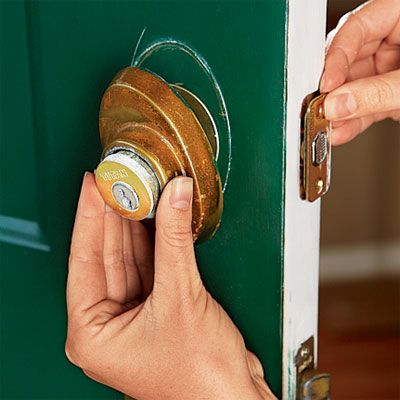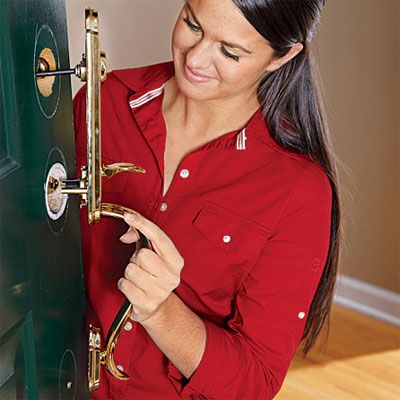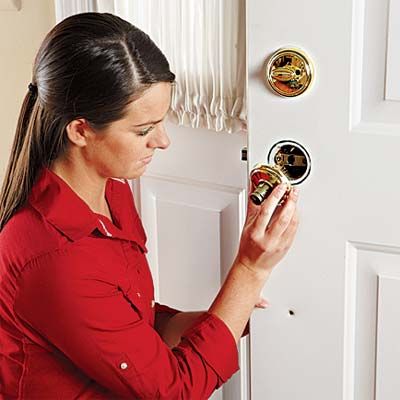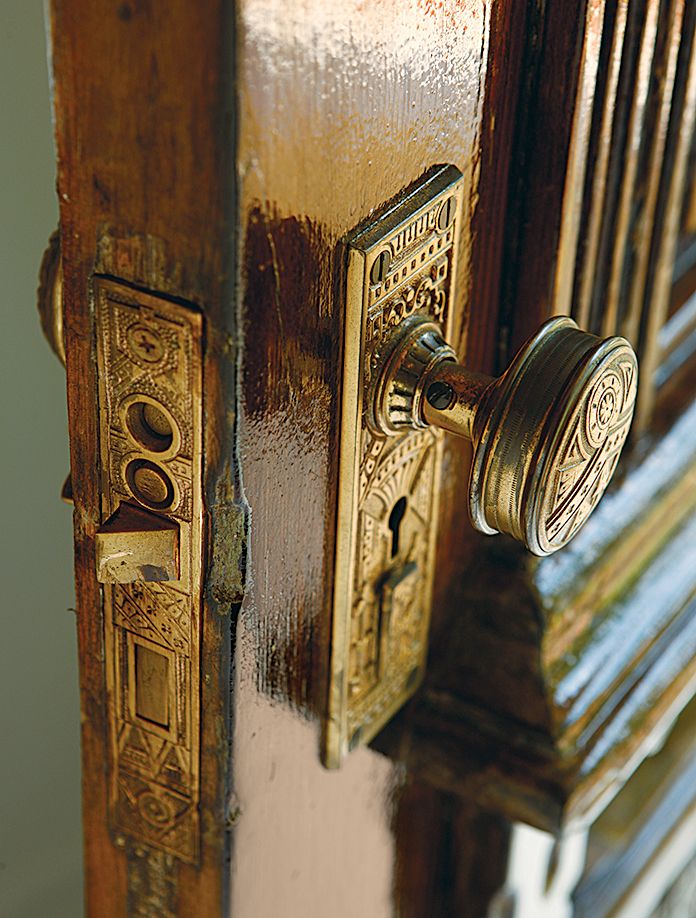Project details
Skill
Cost
Estimated Time
Upgrading your front door hardware is an easy way to boost security and give your home a fresh look. It’s also a manageable do-it-yourself (DIY) project for most homeowners, as it doesn’t require expensive equipment. We’ll break down how to select and install new front door hardware in this guide.
Understanding Your Current Door Hardware
You’ll need to understand your current setup to remove your old hardware and choose a compatible replacement.
Identifying Your Lock Type
Two of the most common types of front door locks are tubular and mortise. Tubular locks are more common in modern homes and are installed in two separate holes in the door. Mortise locks, often found in older homes, fit into a single rectangular cutout in the door’s edge. Identifying your lock type is important for getting the right replacement.
Determining Door Swing
To determine your door’s swing, stand outside facing the door. If the hinges are on the left, you have a left-hand swing door. If they’re on the right, it’s a right-hand swing. This information is key when choosing lever-style handles, as they’re not always reversible.
Measuring Hole Placement
You’ll need to take accurate measurements to find a compatible replacement set. Measure from the knob hole center to the lock hole center to determine the spread. You must also measure the backset, which is the distance from the door’s edge to the knob hole center. Standard backsets are typically 2 3/8 or 2 3/4 inches.
Finding the Right Replacement Hardware
Choosing the right hardware is about balancing style, functionality, and compatibility with your existing door.
Entry Sets: Tubular vs. Mortise Locks
Tubular locks are more widely available and easier to install, making them a popular choice for DIY upgrades. Mortise locks, while more solidly built, often require professional installation. Unless you’re planning to replace your door, stick with the same lock type you currently have.
Selecting a Style That Complements Your Home
Choose hardware that complements your home’s architectural style. For a traditional home, consider classic brass or bronze finishes. Modern homes might benefit from sleek stainless steel or matte black hardware. Glass door knobs can add timeless charm.
Considering Security Features
Look for entry sets with high-quality deadbolts and sturdy construction. Some modern sets offer additional security features like bump-resistant cylinders or reinforced strike plates.
Tools and Materials Needed to Upgrade Door Hardware
To upgrade your front door hardware, you’ll need the following tools:
- Chisel (for adjusting strike plate recess if necessary)
- Drill and drill bits (if new holes are needed)
- New entry set
- New knocker and kickplate (optional)
- Pencil
- Screwdriver (Phillips and flathead)
- Tape measure
Step-by-Step Door Hardware Installation Process
Follow these steps to install your new front door hardware:

Removing the Old Entry Set
- Unscrew and remove the interior knob and thumb-turn lock hardware.
- Remove the exterior handle and lock cylinder.
- Unscrew the faceplates of the deadbolt and latch bolt from the door’s edge.
- Remove the old strike plates from the door jamb.

Installing the New Deadbolt and Latch
- Insert the new deadbolt and latch bolt into their respective holes in the door’s edge.
- Secure them with the provided screws.
- Install the new strike plates in the door jamb, ensuring they align properly with the bolts.
Fitting the Exterior Handle
- Place the new handle over the existing holes in the door.
- Ensure the lock cylinder and thumb latch posts slide smoothly into the deadbolt and latch bolt assemblies.

Securing Interior Hardware
- Fit the lock over the cylinder post and the knob’s spindle-and-rosette assembly on the thumb-latch post.
- Secure both with the provided mounting screws.
- Attach the interior knob to the spindle and tighten its setscrew.
- Insert any additional mounting screws to stabilize the handle base.

Boosting Your Door’s Appearance
After installing the main hardware, consider these additional upgrades to complete your door’s transformation:
- Add a decorative knocker: A stylish door knocker can add character to your entryway. Choose one that complements your new hardware and drill pilot holes for secure installation.
- Install a kickplate: A kickplate protects the bottom of your door from scuffs and scratches. Measure and mark its position, then secure it with screws or adhesive backing.
- Update the door’s finish: If your door’s finish is worn, consider repainting or restaining it to match your new hardware. This can dramatically improve your entryway’s overall appearance.
Troubleshooting Common Door Hardware Installation Issues
If you encounter problems during installation, try these solves for common issues:
- Loose handle: Tighten all screws and check for proper fit.
- Misaligned strike plate: Adjust its position or chisel the recess deeper.
- Sticking lock or latch: Make sure the door is hung correctly and the strike plate is aligned.
Upgrading Door Security
While upgrading your hardware, consider improving your door’s security features. Smart locks offer convenience and advanced security features like remote access and activity logs, and many can be integrated with existing home automation systems. You can also consider adding a door reinforcement plate or longer strike plate screws for increased security. A peephole or video doorbell can be helpful too.
DIY vs. Professional Door Hardware Installation
While many homeowners can successfully install new door hardware, there are situations where professional help is the best option. Consider hiring a locksmith if you’re uncomfortable with the installation process, need to modify the door for a new lock type, or want to ensure the security setup is done correctly. Common DIY mistakes include improper alignment, over-tightening screws, and failing to test the lock thoroughly after installation. Take your time and follow instructions carefully to avoid these issues.
Our Conclusion
Upgrading your front door hardware is a relatively straightforward project that can significantly enhance your home’s appearance and security. While this project is doable for many DIY enthusiasts, don’t hesitate to call an expert if you’re unsure about any part of the installation. The most important thing is that you end up with a secure, functional, and attractive entryway.

